
Shoei RF-1400 Helmet Review: Four Years On, Still Going Strong
left for contents
Choosing a motorcycle helmet should not be a tough task. I’ll make the choice for you, right now:
Get the Shoei RF-1400.
If you ride on the street (or even a bit of track days) and want a safe, comfortable, quiet helmet that’s going to last, this is the one to get.
I’ve had this helmet for four years already as my primary riding helmet, and it still feels like new. I’ve taken it through pouring rain, cold winter weather, steamy Philadelphia summers on everything from rural roads to city streets and massive highways.
This helmet has a pedigree to live up to – the legendary Shoei RF-1200 – yet this helmet exceeded my expectations in almost every way.
Here are the top three reasons I’ve fallen in love with the Shoei RF-1400 over the past four years:
- Quiet Really Does Make a Difference: This is the quietest helmet on the market in my experience, and that matters not just for comfort but for reducing fatigue and allowing you to actually enjoy your music or comms system without blasting the volume.
- Safety Standards Matter, and DOT sucks: DOT is barely a standard, so look for ECE or Snell. The RF-1400 sold in the USA carries the Snell certification, and its identical European version carries ECE 22.06.
- Comfort is King on Long Rides: Forget just the initial feel in the store. A truly comfortable helmet is one you can wear for hours in all kinds of weather without pressure points, hotspots or buffeting. The RF-1400’s liner, ventilation, and wind-tunnel shaped design nail it here.
One of the top motorcycle helmets for street riding due to its incredible safety ratings, solid build construction, versatile shell for street and track riding, and reasonable price. Long term review here.
- Staff pick at Revzilla
- Quietest helmet on the market
- Excellent build quality
- Thick noise-sealing cheekpads
- Visor seal built like Fort Knox
- Snell certified for track use
- Lacking touring comfort features like drop down sun shield
Let’s dive into why the Shoei RF-1400 has become my go-to helmet for street riding and why it might just become yours too.
My Helmet Hunt: Safety First
Helmet shopping can be overwhelming. Between cost, fit, style, and the need for a proper safety certification, there’s a lot to consider. When I was in the market for a new street helmet, I spent weeks reading every review I could find on brands such as Arai, AGV, HJC, and Ruroc. I asked around at local bike meetups and rides.
I wanted the safest option available. DOT alone wasn’t enough for me, so I started looking at Snell and ECE standards.

That’s when the Shoei RF-1400 popped up on my radar. In the United States, the RF-1400 carries a Snell M2020 and DOT certification. Its European twin (called the NXR2) meets ECE 22.06. While the US model doesn’t bear the ECE label, it’s essentially the same piece of gear.
After scouring forums, watching helmet tear-downs, and trying the RF-1400 on at a local shop, I was sold.
Yes, the price stung a bit, but I was convinced I’d be investing in top-tier protection for years to come.

There was also Shoei’s reputation to consider: rock-solid build quality, plush interiors, and aerodynamic designs that keep noise in check. The previous generation, the RF-1200, was a favorite among many riders. By all accounts, the RF-1400 built on that foundation and then some. I took the plunge, and I’m happy to report it’s been my one and only helmet for nearly four years. From highway blasts to pothole-riddled city streets, this helmet has seen it all.
Let’s get in to where it shines… especially in the noise department.
The Quietest Helmet Ever
Perhaps even more impressive is the lack of roaring wind noise. The RF-1400 is noticeably quieter than any helmet I’ve owned or ridden in before. Part of this comes from that sleek shell shape and Shoei’s addition of little details like vortex generators along the sides of the visor to smooth out airflow. It also has an airtight shield seal and plush ear padding that work together to muffle wind roar.
At 75 mph behind a minimal windscreen, I can actually hear my bike’s engine note and even carry on a conversation via my Sena headset without shouting. Riding on the open freeway feels serene, not deafening.
Aerodynamic Stability
Aerodynamic stability isn’t just a marketing phrase – it’s something you feel on long rides. I’ve ridden through sudden storms where wind blasts hit me from all sides. The RF-1400’s shell shape really proves itself here.
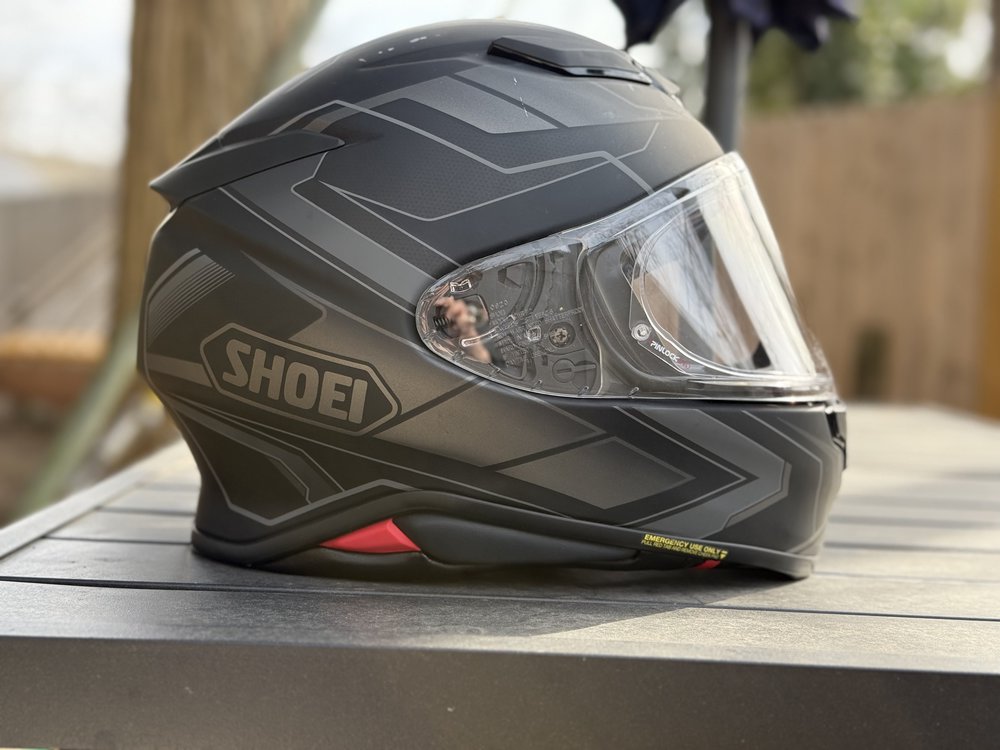
There’s minimal lift when you pop up over a hill crest or shoulder-check at speed, so the helmet doesn’t try to pull upward or strain your neck. Shoei’s design practically eliminates that “sail effect” you get with lesser helmets, where a turn of the head can jerk you off balance. I find I can do head-checks on the highway to change lanes without the helmet catching air and forcing my head back.
Shoei truly nailed the wind dynamics on this lid, and I don’t say that lightly. After four years, the quiet and stability at speed are still among my favorite aspects of the RF-1400 – it makes high-speed cruising remarkably comfortable.
Excellent Ventilation for Heat and Humidity
You might assume that a helmet this quiet must compromise on airflow – but Shoei proves you can have both. The ventilation system on the RF-1400 has been a savior during brutally hot rides. I live in Philadelphia, where summers can hit 100°F (35°C) with 100% humidity, so I’ve tested this ventilation to its limits.
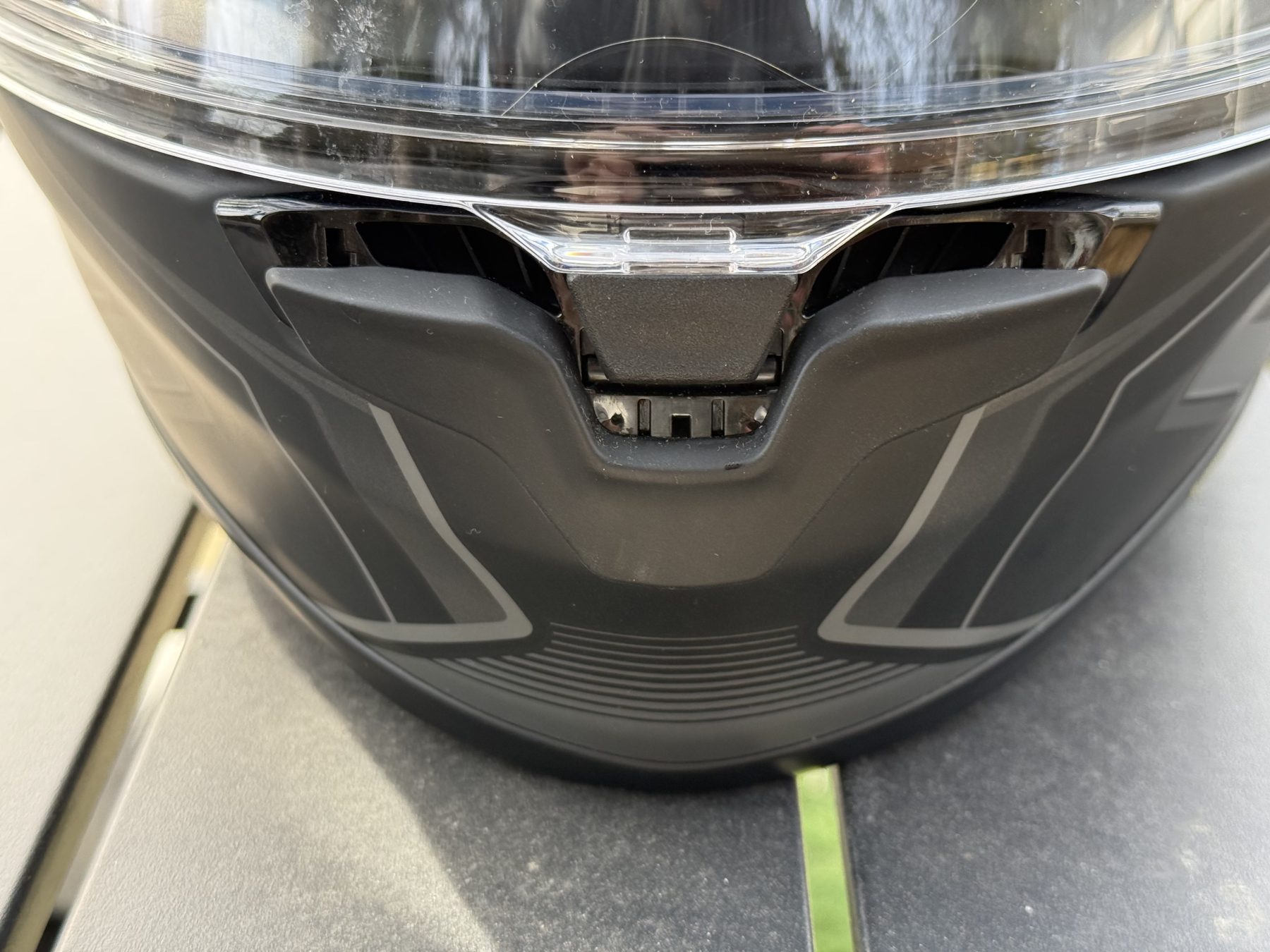
In city traffic at triple digit temperatures with swampy humidity, a full-face helmet can feel like an oven on your head. But the RF-1400 manages to keep me surprisingly cool when I’m crawling through congested streets in August. Shoei redesigned the vents from the previous generation – they relocated the central forehead intake and even added an extra intake hole to gulp in more air.

At the same time, the strategically-placed (and huge) rear exhaust vent creates a vacuum effect that pulls hot air out of the helmet while you ride. The difference is noticeable: as soon as I’m moving even at 20-30 mph, I feel a gentle flow of air across the top of my head and around my cheeks.
All the vents have closed, open, or half open positions – which I’ve found super handy for those iffy days that can’t decide whether they’re hot or cold.
Managing Rain and Fog
Ventilation isn’t only about heat; it also helps with fog management. But even a well-ventilated helmet with a poorly built visor will fog up, forcing you to crack the visor and potentially make you worse off in your battle against the weather.
The usual solution for this is a Pinlock anti-fog insert, and the RF-1400 comes with one in the box.
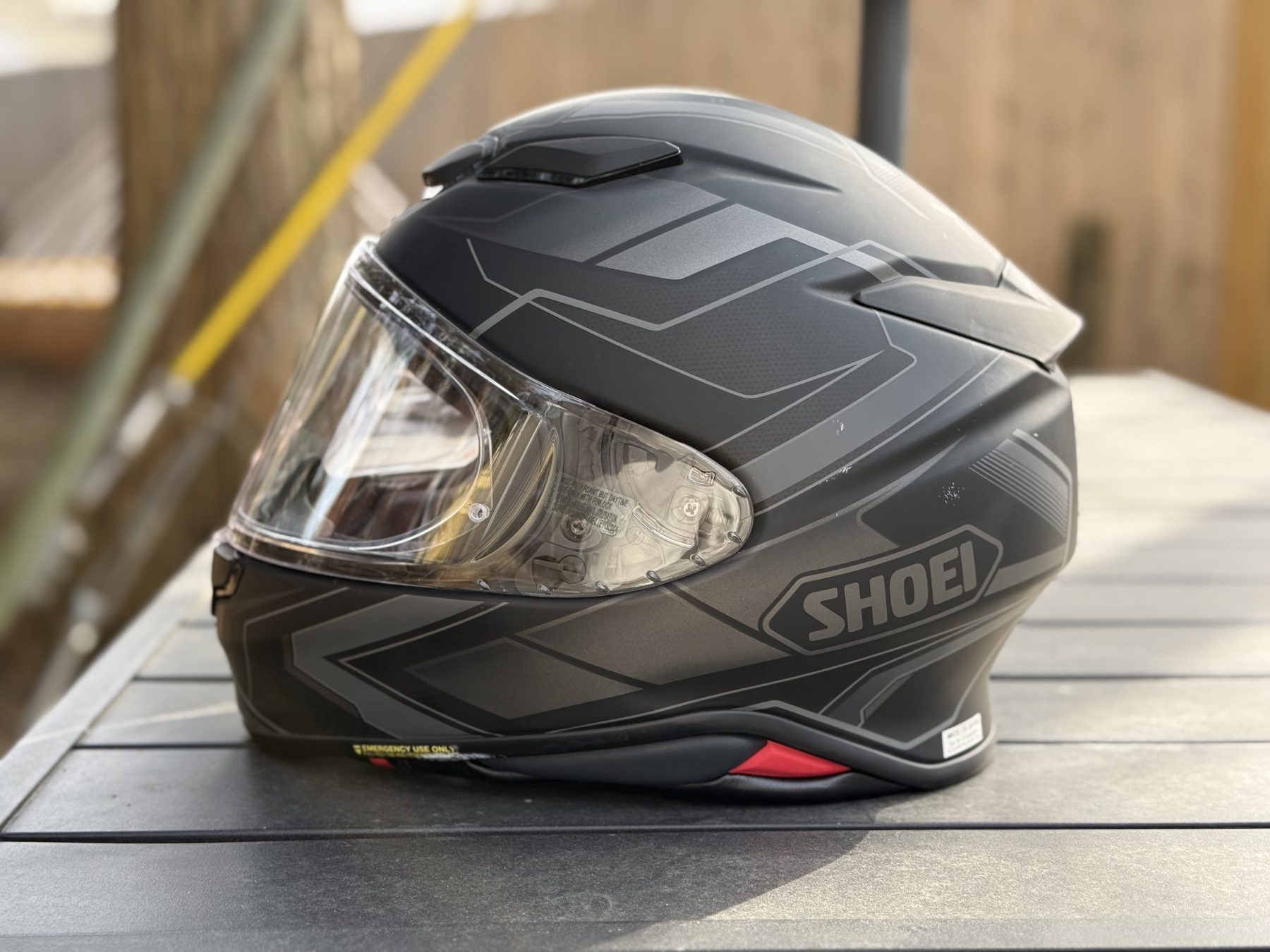
That Pinlock, combined with the vents, has kept my vision crystal clear in rain and cold, and I can even close the vents if it’s particularly cold without losing my vision to fog.
It’s worth mentioning the RF-1400’s visor mechanism has a small “city position” detent – a slight open position – that lets you get a trickle of extra airflow without having the visor flapping. It’s great for demisting at a stop or just getting a bit more breeze when slogging through stop-and-go traffic. And unlike some helmets where an open visor position might slam shut if you turn your head at speed, the Shoei’s visor stays put, thanks to its sturdy detents.
In short, whether it’s a 100% humidity city ride or a cold rainy day in the spring, the RF-1400’s ventilation has impressed me. You get the airflow you need when you need it, and you can shut it down when it’s chilly or wet. It’s a tough balance to strike, but this helmet handles it beautifully – cooling without becoming noisy. I’ve grown to absolutely trust it for all-season riding.
All-Day Comfort & Custom Fit
Comfort is king when you wear a helmet for hours on end, day after day. Shoei helmets have a reputation for plush interiors, and the RF-1400 is no exception. But beyond just initial comfort, this helmet truly shines on long rides – the kind of rides where a minor pressure point can turn into major pain after 300 miles. After four years, I can confidently say the RF-1400’s comfort and fit are outstanding, especially once you dial it in for your head shape.
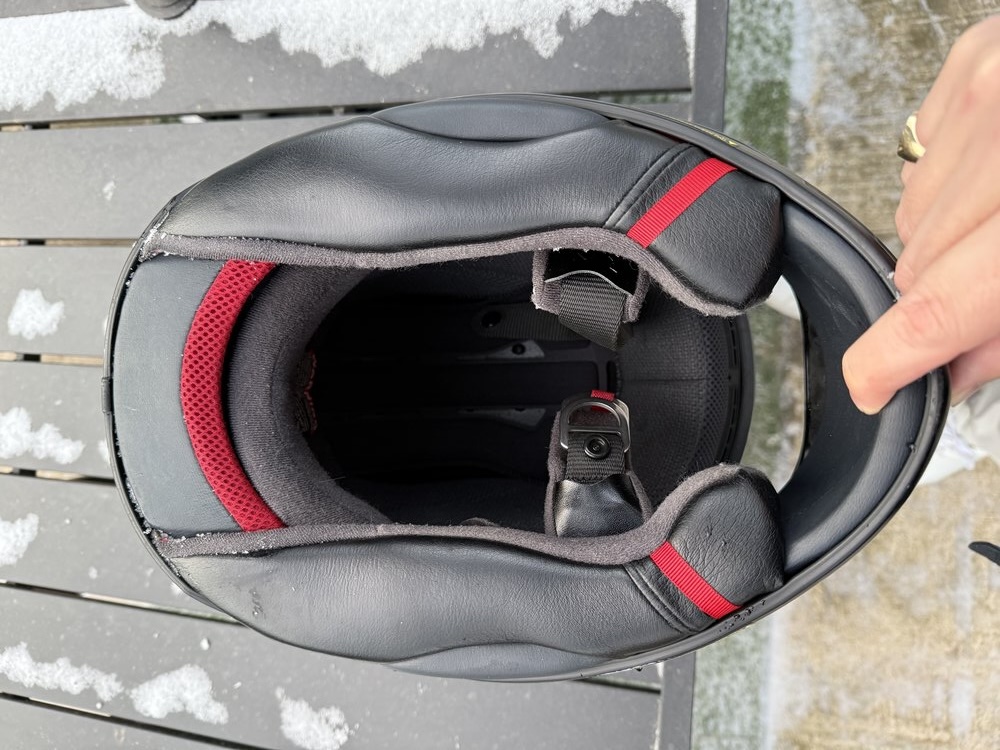
Snug, Secure, and Plush
My very first ride with the RF-1400 was a 6-hour day, and I was bracing for the usual “new helmet headache” from tight cheek pads. Indeed, out of the box the fit was quite snug (I like my helmets fitting on the tighter side for safety). The cheek pads gave me a bit of the chipmunk cheeks look initially, but they broke in nicely after a couple of weeks of regular use.
Shoei uses a 3D Max-Dry interior that is not only soft to the touch but also compresses and molds to your face over time. The fabric is designed to wick sweat and dry quickly (Shoei claims it dries twice as fast as traditional nylon materials). In practice, I’ve found that even on hot days my head doesn’t feel swampy – the liner does a great job of managing perspiration.

What I love is that after the break-in period, the RF-1400 became my perfect fit. The pressure is evenly distributed with no hot spots on my forehead or ears. Even on a 700-mile weekend tour (about 6 hours of riding each day), I experienced zero discomfort – no sore ears, no red mark on my forehead, nothing.
That’s a testament to Shoei’s internal shape being well-suited to my intermediate-oval head and the quality of the padding. The interior is fully removable and washable, by the way, and I’ve given it a good cleanse at least once a year. It always comes out looking almost new, which speaks to the material durability.
Customizable Padding and Fit Adjustment
One size doesn’t fit all when it comes to helmets, and Shoei gets that. One of the unsung benefits of choosing a premium brand like Shoei is the availability of different pad sizes and their “personal fitting” system. In some Shoei stories / dealers, they will custom fit your Shoei by mixing and matching pad sizes (or even adding padding) for you in-store.
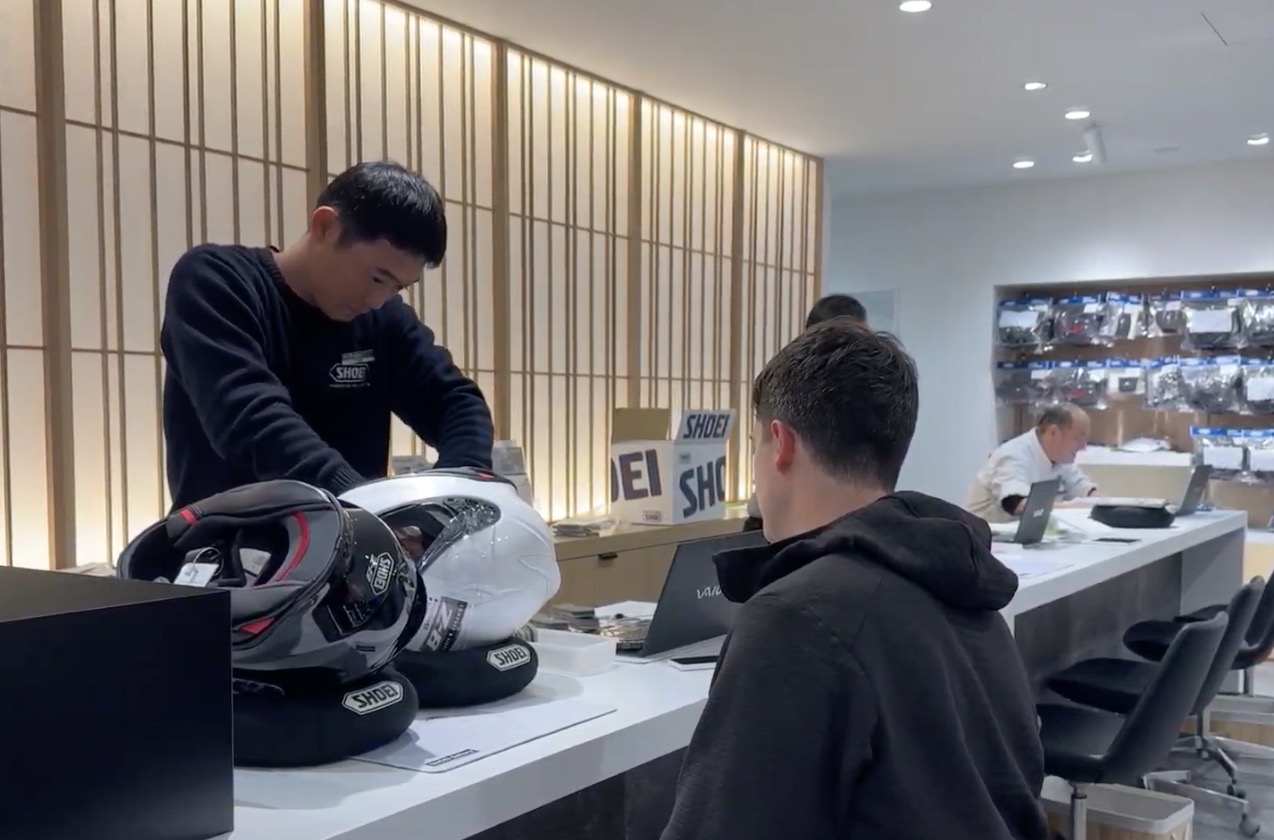
This kind of customization is a big deal – it can turn a good fit into a perfect fit if you have a unique face shape. Or, just help you refresh a perfectly good helmet with padding that’s a little too “broken in”. I haven’t used that service, but it’s nice to know it exists.
I also appreciate the little details that add to comfort: for example, the RF-1400 has removable ear pads that cover the ear speaker pockets. Since I installed a Bluetooth comm system (Sena 50S) in my helmet, I removed those small pads to fit my speakers in.
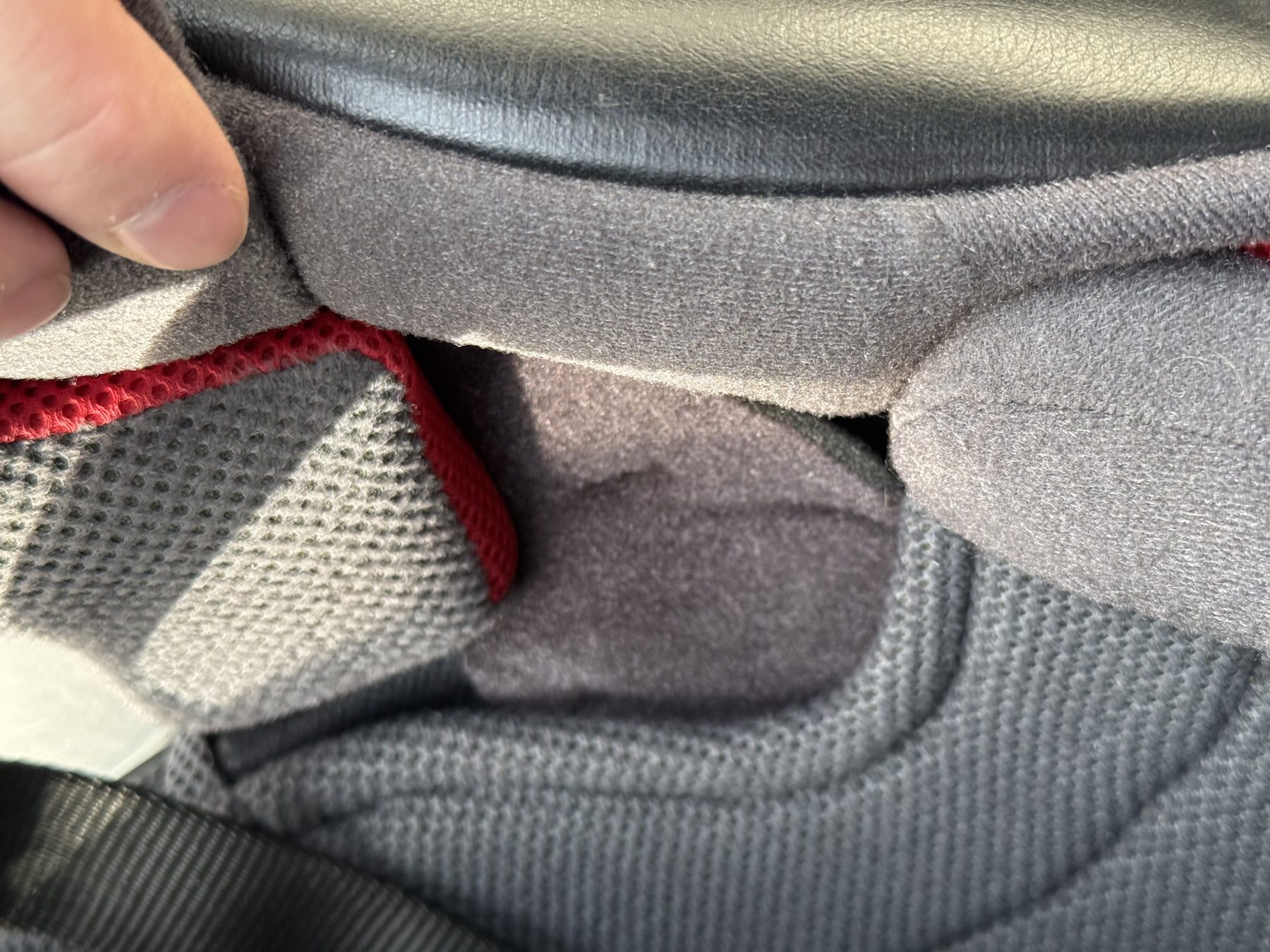
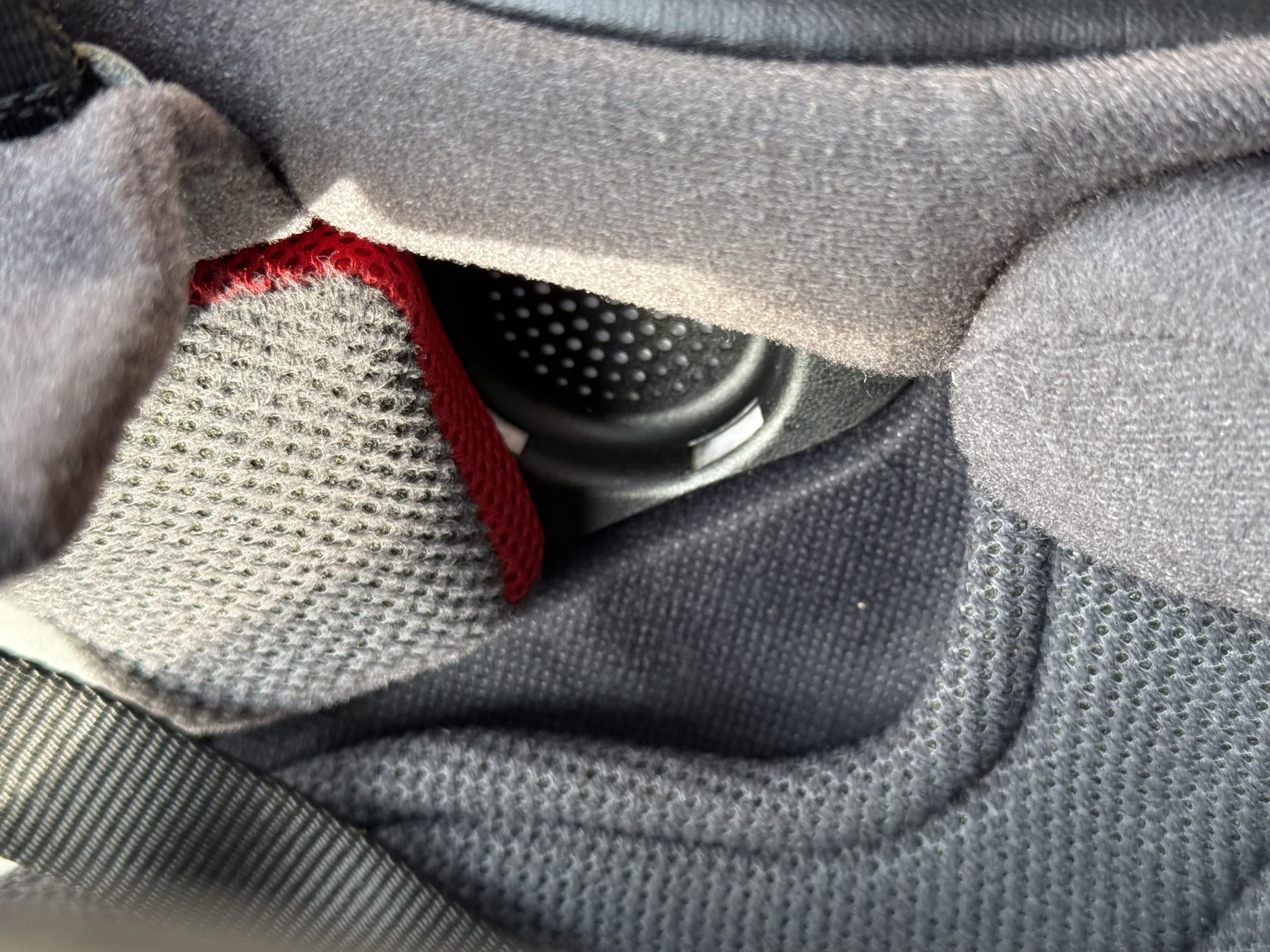
The speaker recesses are just the right depth – my ears don’t press against the speakers, which prevents soreness. If you don’t use a comms unit, those pads help reduce noise, but if you do, Shoei designed the helmet to accommodate it without compromising comfort or noise levels. My Sena mounted easily on the shell, and the speakers don’t push on my ears at all.
Another point on comfort: this helmet is very well-balanced. At around 3.5 pounds, it’s not the absolute lightest helmet on the market (ultra-light race helmets or the AGV K6 weigh less), but the weight is distributed so evenly that I hardly notice it. I’ve worn lighter helmets that felt heavier because they were unbalanced or caught wind. The RF-1400, even after a full day, doesn’t give me neck strain. I think the aerodynamic design helps here too – less tugging from wind means less fatigue.
After four years, the interior is still in great shape. No fraying, no flattening beyond what happened in the initial break-in. I expect I’ll eventually replace the comfort liner, but so far a good wash has been enough to keep it fresh.
Knowing Shoei offers replacement liners, cheek pads, and even a 5-year warranty gives me confidence that this helmet is a long-term investment. And it’s an investment in my comfort as well as my safety. I’ve come to really cherish how the RF-1400 “disappears” on my head during a ride – I often forget I’m wearing it, which is about the highest compliment you can give a helmet’s comfort.
Crystal-Clear Visibility & Shield System
When you’re dodging city traffic or carving up mountain roads, visibility is everything. The RF-1400 provides an expansive field of view and an outstanding visor system that has proven its worth to me time and again. Let’s talk about the face shield: how it performs in daily use, in bad weather, and why I think it’s one of the best designs out there right now.
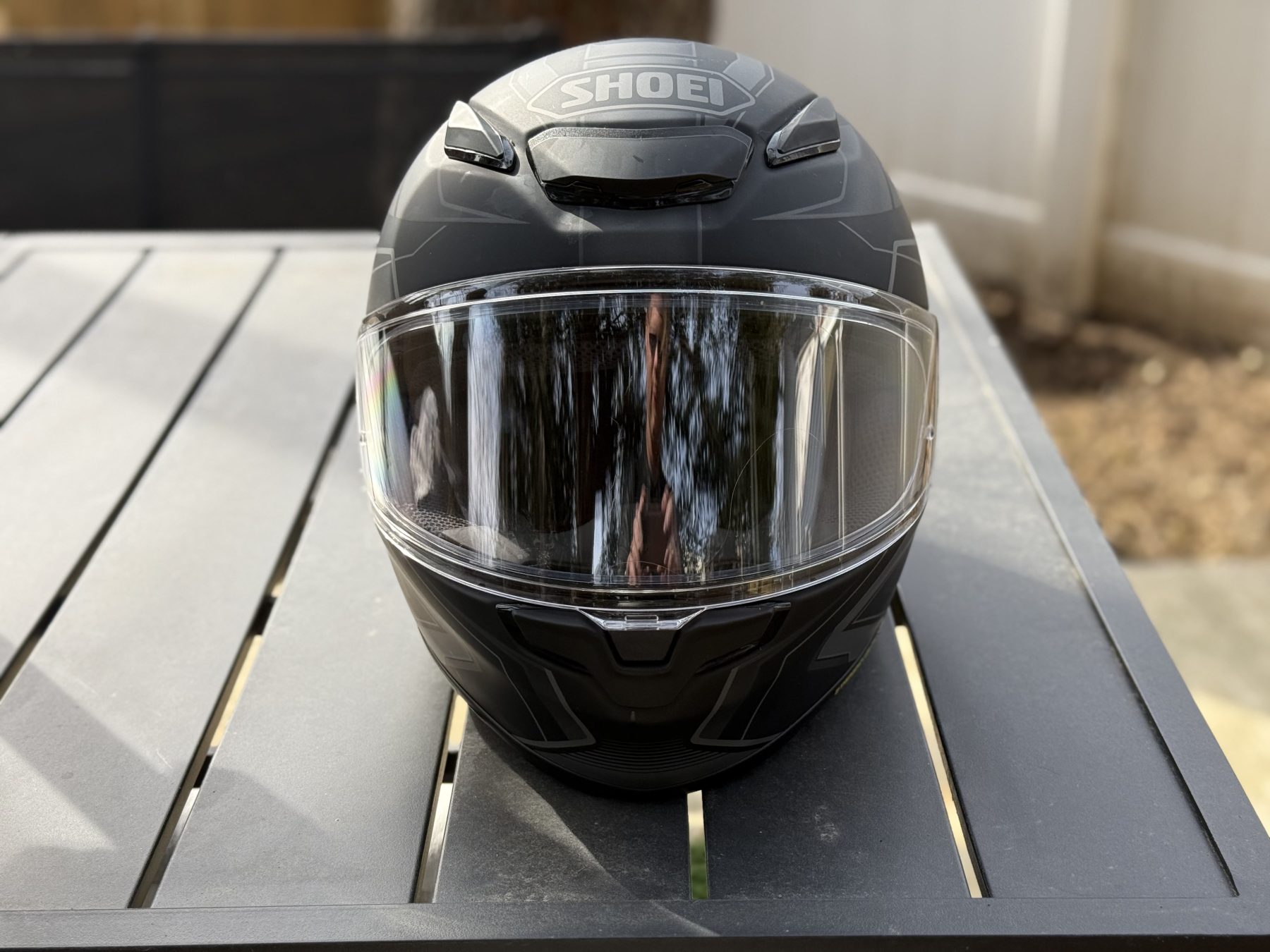
Panoramic Field of View
Shoei slightly enlarged the eye port on the RF-1400 compared to its predecessor, the RF-1200. I wasn’t sure I’d notice that in practice, but I absolutely did. The first time I merged onto a busy highway wearing the RF-1400, I realized I had great peripheral vision – I can check my blind spot without straining or feeling like I’m looking through a porthole. According to one shop that measured it, the new visor is a bit taller and the Pinlock pins were moved outward to give about a 10% wider view than the RF-1200.
All I know is that I never feel claustrophobic or limited. Whether I’m in dense city traffic or fast switchbacks, the wide field of view helps me stay aware of cars, bikes, or wildlife that might be lurking in my periphery.
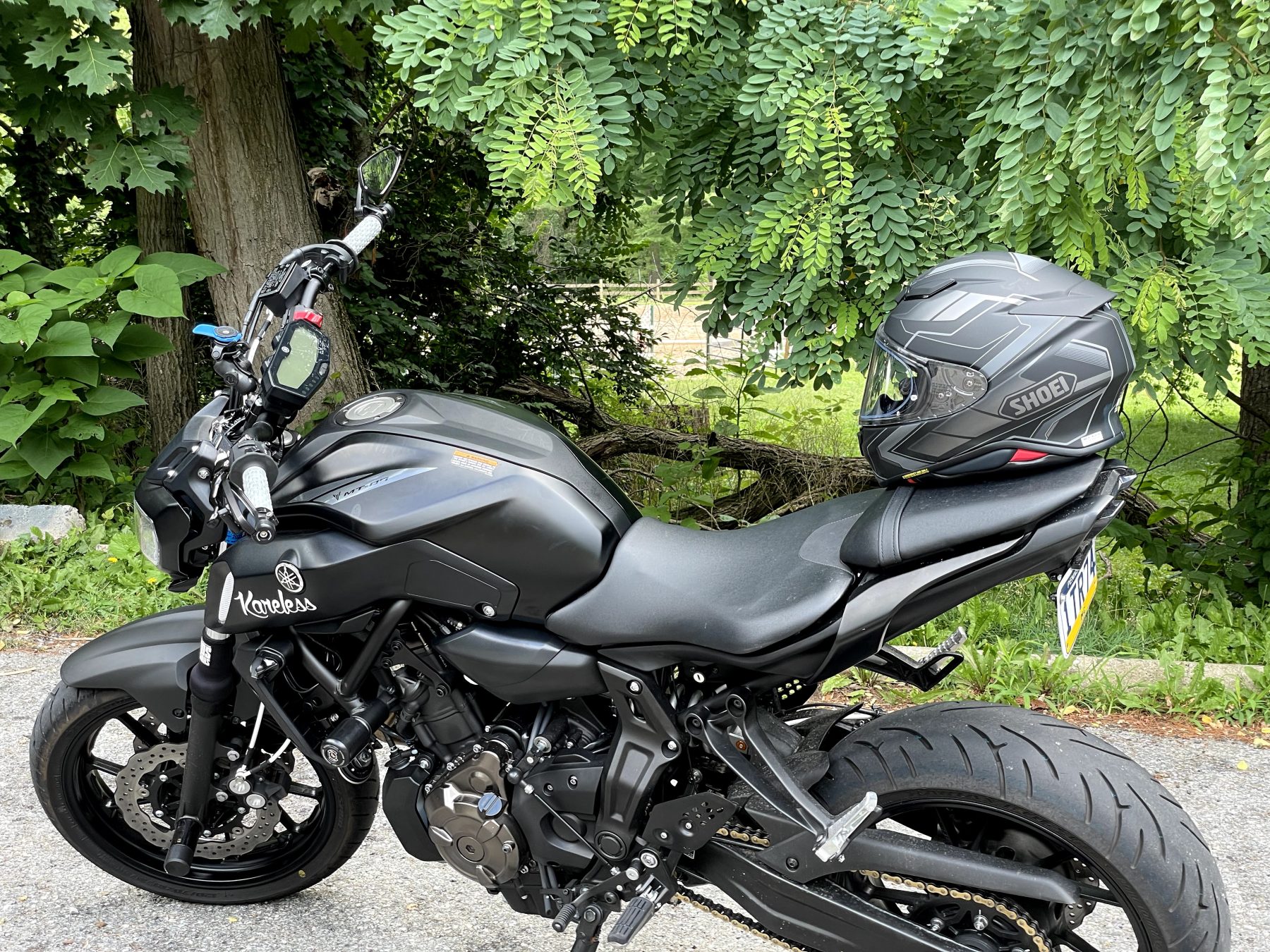
Even off-road on some dirt trails (yes, I’ve taken this “street” helmet on light dirt adventures), I liked the fact I could glance down and see my instrument cluster and GPS easily, as well as scan the trail ahead without moving my whole head. It’s not as huge a viewport as an off-road or ADV helmet, but for a full-face street helmet, it’s excellent.
Shield Locking Mechanism & Operation
The RF-1400 introduced a new center locking mechanism for the face shield, which was a change from the off-center latch on older Shoeis. I’ll admit, at first I fumbled with the center latch – muscle memory had me reaching to the side. But after a day or two it became second nature, and now I vastly prefer this design. Why? Because it secures the visor evenly on both sides and feels more positive. With a simple press of my thumb at the center, the shield cracks open. Press it firmly and it clicks as it locks. It’s easy to find even with thick gloves on, and being in the center means I can open it with either hand.
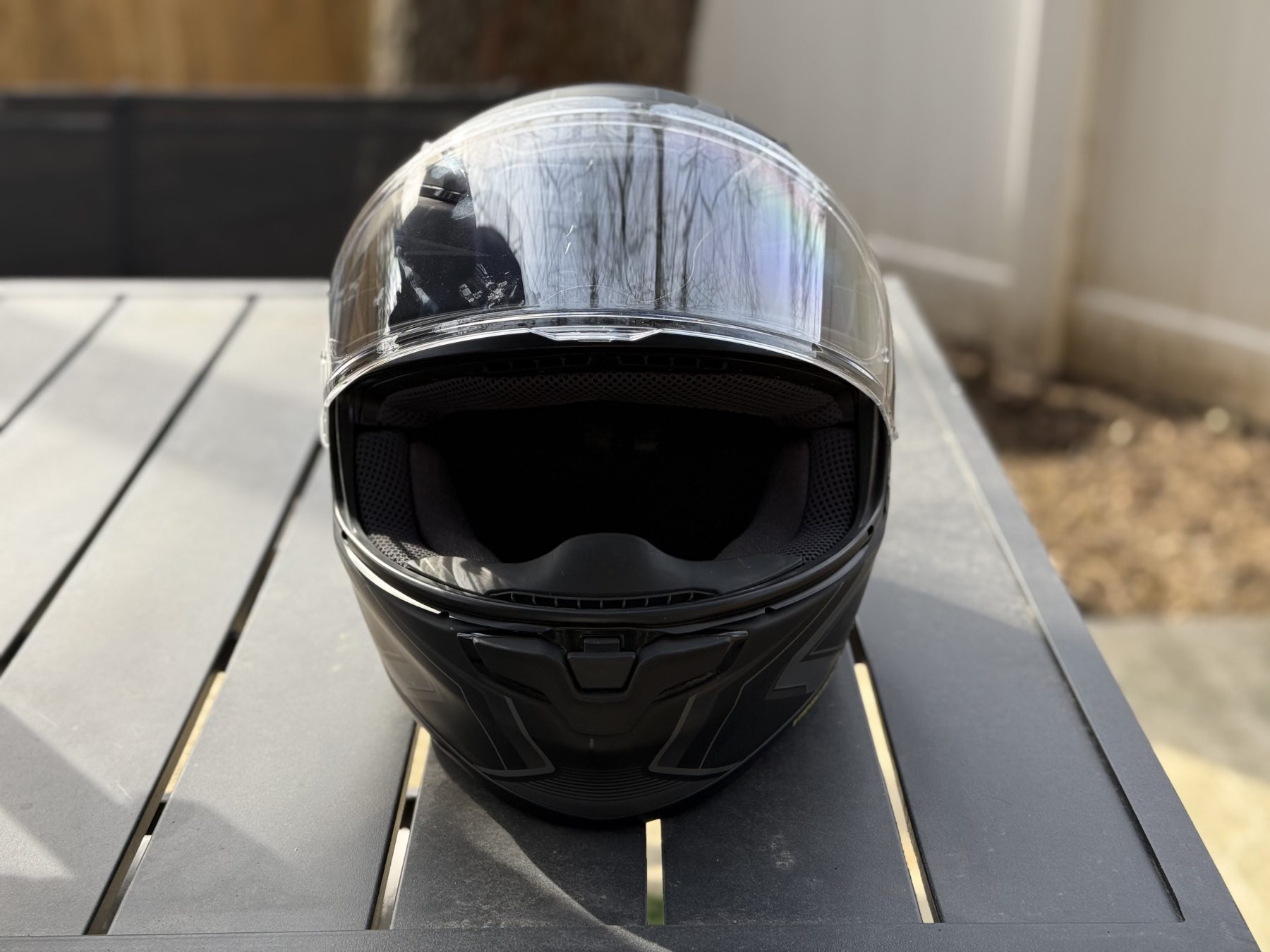
That locking mechanism has two major benefits I’ve felt:
- It prevents accidental opening or closing. Hitting a headwind or turning my head at high speed never causes the visor to pop open or slam shut unexpectedly. It stays exactly where I set it, even if I only want it open one tiny crack for airflow.
- It creates a tight seal when closed. No whistles, no water leaks. When I shut the visor completely, it compresses against the seal uniformly. I’ve ridden hours in torrential rain and not a single drop got in at the top of the visor. And when it’s closed, combined with that excellent seal and spring-loaded base plates, it really helps keep wind noise out (as mentioned earlier).
Opening and closing the shield is smooth, with distinct detents. It has multiple open positions ranging from a tiny crack (great for defogging) to half-open, all the way to fully flipped up. The detents are strong enough that the visor stays where you put it until you deliberately move it. And at fully closed, there’s that reassuring click of the lock. Even after a few years of regular use, the mechanism hasn’t loosened up or weakened – it still feels as secure as day one, which speaks to Shoei’s build quality.
Optical Clarity & Lack of Sun Shield
Shoei’s visors are known for good optical clarity and the RF-1400’s shield is no exception. It’s distortion-free edge to edge. I do a lot of night riding, and I haven’t experienced weird distortions or excessive glare from oncoming headlights.
The Pinlock EVO insert, which I mentioned before, is a game changer for fog prevention. It comes in the box – you just have to install it on the visor (it’s straightforward, takes 2 minutes). With the Pinlock in place, I’ve literally never had the visor fog up on me while moving. Only if I stop in cold rain without cracking the visor can a little fog start at the bottom, but one notch open and it’s gone.
For winter riders or anyone in wet climates, Pinlock is essential and I’m glad Shoei includes it. Even without the Pinlock, the ventilation alone did a decent job in mild conditions, but I rarely go without it because it works so well.
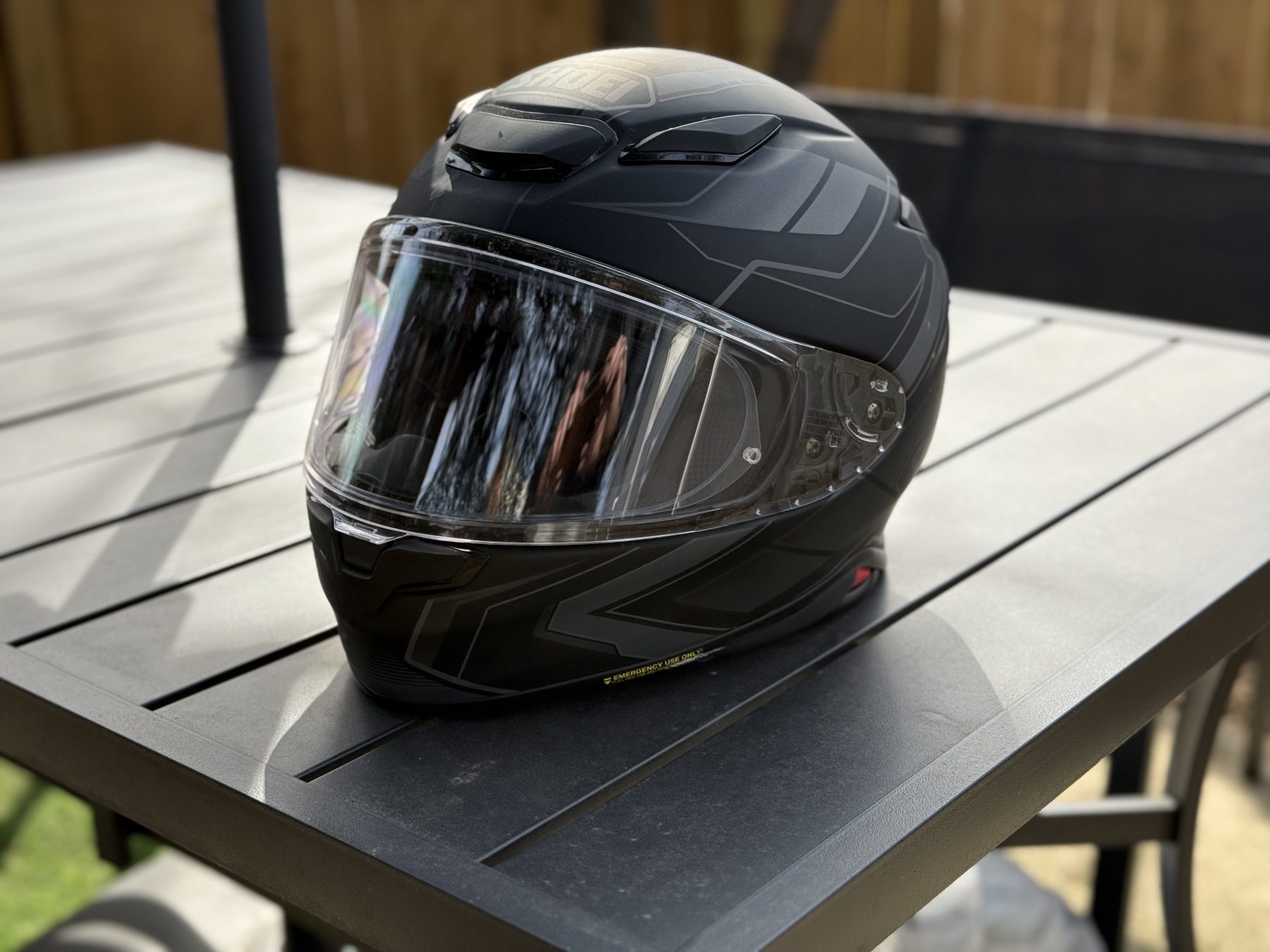
Now, one of the drawbacks often mentioned for the RF-1400 (and other premium full-face helmets) is the lack of an internal sun visor. Shoei chose to keep the helmet Snell-rated and compact, which means if you want sun protection, you swap to a tinted shield or wear sunglasses. Personally, I prefer this trade-off because it keeps the weight down and avoids another moving part in the helmet. I often wear sunglasses or use a tinted visor on bright days.
And, Shoei offers a Transitions photochromic shield for the RF-1400, which automatically tints in sunlight. I haven’t invested in one (they’re pricey) but that does essentially give you an “internal sun visor” effect but using the main shield itself, without any action on your part.
The bottom line is the RF-1400 gives me total confidence in my visibility. It doesn’t impede my view of the road, it doesn’t fog up, and it’s easy to operate even with gloves on. When I’m riding through a gorgeous mountain vista, I almost forget I have a shield in front of my eyes – it’s that clear. And when I’m riding through nasty weather, I feel protected and in control thanks to the visor system. For a component that you use every single ride, Shoei has absolutely nailed the design here.
Top-Tier Safety & Build Quality
All the comfort and features in the world mean nothing if a helmet doesn’t protect you when it counts. The RF-1400 does not cut any corners when it comes to safety: the US version carries the Snell M2020 certification (the gold standard in the USA for impact protection) and the European version carries the ECE 22.06 certification. In independent SHARP testing (a UK government testing program), the European model (Shoei NXR2) earned a full 5-star safety rating. That’s about as good as it gets for helmet safety credentials.
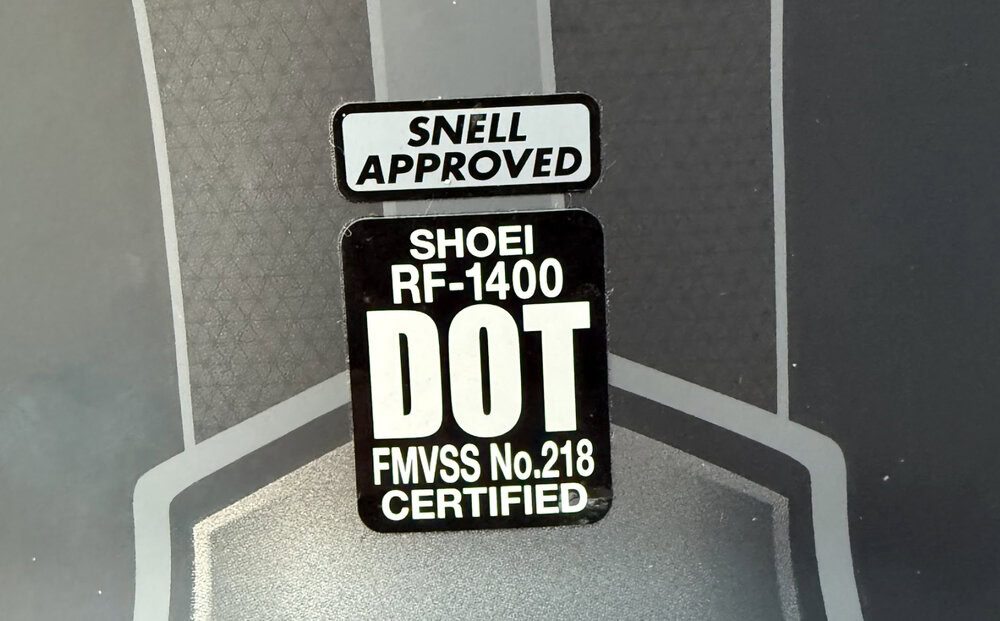
Shoei uses their proprietary AIM+ (Advanced Integrated Matrix Plus) shell, which is a fiberglass composite that’s both strong and lightweight. It’s not a cheap polycarbonate helmet – this is a hand-laid fiber shell designed to absorb and distribute impact forces. Inside that, there’s a multi-density EPS foam liner that is thicker in certain areas to handle different impact energies.
Thankfully, I haven’t had to test the RF-1400’s protection in a major crash, and I hope I never will. But after 4 years of regular use, the finish on the helmet (mine is a subtle grey design) still looks great after years of use; it’s resistant to minor scratches and UV fading.

The Emergency Quick Release cheek pad system is a feature I fortunately have not needed, but I’m glad it’s there. If I ever crash and need medical help, first responders can pull the red tabs to pop out the cheek pads and gently remove the helmet with less risk to my neck. It’s one of those safety features you don’t think about until you need it – and I always point it out when I ride with new folks, just in case.
Confidence on Every Ride
Knowing the RF-1400 is Snell-certified was actually a major reason I bought it in the first place. I am not a regular track day guy, but many tracks require a Snell rated helmet so I have the option to go if I want. The Shoei ticked that box, whereas some competitors (especially ones with internal sun visors or more budget helmets) do not.
Safety isn’t just about lab tests though. It’s also about how the helmet performs in making you a safer rider. The RF-1400’s comfortable fit means I’m not distracted by pain or pressure. Its quiet ride means I’m less fatigued and can pay more attention to traffic. Its visibility means I can react quicker to hazards.
All these factors contribute to active safety – preventing crashes in the first place. That’s something I value that as much as the helmet’s ability to protect in a crash.
Lastly, I’ll say that after four years, all the helmet’s functional pieces (vent sliders, shield latch, interior foam) are still in great working order. I’ve read horror stories of cheaper helmets where vents snap off or the liner literally turns to dust after a year.
With my Shoei, everything feels as solid as day one. I do take care of it – cleaning it regularly, storing it in a padded bag, etc. – but I think even if I didn’t, it would hold up well. The build quality truly matches the premium price tag, and that gives me the confidence to keep using it daily, knowing it will perform if and when I need it most.
Considerations Before You Buy
No product is perfect, and in the spirit of a fair review, I want to highlight a few considerations and minor downsides about the Shoei RF-1400. These are not deal-breakers for me, but they are things a potential buyer should be aware of:
Premium Price: This helmet sits at the high end of the price spectrum. Solid colors start around $650 USD, and graphic designs or special editions can run $700-$800. Add a photochromatic or mirrored shield, and you’re looking at another ~$150-200. It’s a serious investment. In my opinion, the long-term comfort, quality, and safety are worth it – I see it as an investment in my head. But if budget is your main constraint, you’ll need to decide if these features justify the cost.
Conservative Style Choices: Shoei offers a variety of colors and graphics for the RF-1400, but compared to some trendier brands, the designs are more traditional. You won’t find wild neon graffiti designs or Marvel superhero themes straight from the factory (if that matters to you). I actually love the understated look of my helmet – it’s a classy design – but riders who want a helmet that really stands out might feel a bit limited. (On the bright side, you can always add custom decals or get a custom paint job if you want Shoei’s quality with a unique look.)
Limited Shield Color Options: Unlike a brand like Ruroc that sells a rainbow of crazy colored visors, Shoei sticks to the basics. The RF-1400’s stock shield is clear, and official extras include light smoke, dark smoke, a few mirrored tints (like blue or gold), and the Transitions photochromic shield. Don’t expect hot pink or iridescent green factory visors here. This isn’t a big negative for me, but it’s worth noting if you love to color-match your helmet to your bike or gear.
No Internal Sun Visor: As mentioned, this helmet foregoes an integrated drop-down sun visor. Some riders coming from a touring helmet with that feature (like Shoei’s own GT-Air series or some HJC and Schuberth models) might miss it. It means you either carry a spare shield or use sunglasses/Transitions.
Fit is Personal: The RF-1400’s internal shape is an intermediate oval leaning slightly towards neutral round. For most Western/European riders this is a comfortable shape, but if you have a round head shape, you might find pressure on your forehead. In that case, a helmet like the Arai Quantum-X (which is built for round heads) might fit better. The takeaway is try it on if possible. Also, the helmet is offered in multiple shell sizes (Shoei uses four shell sizes for XS-XXL), so you don’t end up with a bobblehead look in a small size. Just ensure you get the right size and shape for your noggin. Fit is not only comfort, but safety.
To be clear, none of these points diminish my overall enthusiasm for the RF-1400. They’re more like practical trade-offs to be aware of. For me, the pros overwhelmingly outweigh these cons – and it might be the case that none of the above points are cons for you!
Shoei RF-1400 vs The Competition
When spending this kind of money, it’s only natural to compare the RF-1400 to other top helmets in the market. I did the same, and over the years I’ve had the chance to test or at least try on some of its main competitors. Here’s a quick look at how the RF-1400 stacks up against a few notable premium helmets:
Arai Signet-X
Fit and head shape are the biggest differences between these two. The Signet-X is designed for a long-oval head (very elongated front-to-back). If you have a long, narrow head profile, the Arai will likely fit you better than the Shoei, which is more intermediate oval. Both helmets are premium quality and Snell M2020 rated, so safety is top-notch in either.
Purpose-built for long‑oval heads, the Arai Signet‑X delivers exceptional comfort, top-tier Snell-rated protection, and robust ventilation—all without pressure points or fit compromises.
- Long-oval: no forehead hotspots
- Lightweight: less fatigue on long rides
- Excellent airflow: stays cool in heat/traffic
- Snell M2020/DOT; adjustable padding
- Vent-heavy design can be noisy
- Face-shield latch is stiff with gloves
In my experience, the RF-1400 is a bit quieter at highway speed, while the Arai offers comparable ventilation but with a bit more wind noise due to its vent design. Both have great shields and pinlock visors. Neither has an internal sun visor. Price-wise they’re similar.
Verdict: If your head shape demands a long-oval helmet or you prefer Arai’s ethos, the Signet-X is an excellent choice. For most riders, though, the Shoei’s more neutral fit and quieter ride give the RF-1400 an edge.
AGV K6 S
Ultra-light weight is the AGV K6 S’s calling card. It feels almost featherweight compared to the RF-1400 (you can immediately tell the difference when you pick it up). If minimal weight is your top priority, the K6 is a strong contender. I found it comfortable and well-ventilated, but a bit noisier at highway speeds than the RF-1400. The visor seal on the Shoei also felt more effective (hence less wind noise).
A lightweight and aerodynamic helmet designed for ultimate comfort and protection, inspired by MotoGP technology.
- Ultra-light composite shell reduces fatigue
- 190° field of view enhances road awareness
- Aerodynamic design with low wind noise
- Excellent ventilation with multi-vent airflow
- Eyeglass-friendly interior and comms-ready
- Vent sliders can be fiddly with gloves
- Compact sizing—double-check shell fit
The K6 is ECE certified (and DOT) but not Snell. That might matter if you want a track-legal helmet in the US, though for street use it’s not a big issue. AGV includes a Pinlock insert with the K6 S (good on them), and like the Shoei it lacks an internal sun visor in favor of keeping weight down and structure solid.
The price of the K6 S is a bit lower – usually around $500-$600. So it can save you some money and some grams.
Verdict: The AGV K6 S is perfect for riders who prioritize low weight above all else. It gives up a little in noise isolation and doesn’t have the Snell rating, but it’s still a premium helmet. If you want the quietest ride and a slightly more solid feel (and/or need Snell for track days), the Shoei RF-1400 remains the better all-rounder for me. I personally use the RF-1400 for my long rides, but I wouldn’t mind a K6 as a secondary helmet for short, spirited rides around town.
HJC RPHA 71
The HJC RPHA 71 aims to deliver a premium experience at a slightly lower price point. One big feature it offers that the Shoei doesn’t is an internal drop-down sun visor for instant shade. In use, the RPHA 71 is comfortable but quite a bit louder than the RF-1400 and fairly quiet – in the same ballpark as the RF-1400 for noise, maybe just a touch louder at certain speeds.
A lightweight sport-touring helmet combining performance, comfort, and sleek design.
- Aerodynamic shell with excellent stability at high speeds
- Advanced moisture-wicking interior with removable padding
- Integrated sunshield and Pinlock-ready face shield for versatile visibility
- Bluetooth system compatibility requires separate purchase
The built-in sun visor mechanism does add a bit of weight, and the HJC is not Snell certified (it is ECE 22.06 rated). The fit is a tad more oval/wide, so riders with broader faces might find it immediately comfortable (it doesn’t squeeze the cheeks as much as the Shoei). HJC also designed the helmet to integrate their Bluetooth comm system nicely, which is a plus if you want to use that specific Sena Bluetooth unit.
Even though the RPHA 71 comes with a premium price point and a composite shell, it lacks ECE or Snell ratings. All you get is DOT, which doesn’t inspire confidence.
Where the RPHA 71 really stands out is value: solids start around $500, which is a good chunk cheaper than the Shoei. You’re getting nearly all the features for less money.
Verdict: If you want a high-quality sport-touring helmet with an internal sun visor and you’d like to save some cash, the RPHA 71 is a compelling choice. It might not have the absolute refinement or Snell rating of the RF-1400, but it’s very close. In my case, I still favor the Shoei for its slightly better noise control and that Snell sticker, but HJC has narrowed the gap tremendously with the RPHA 71.
Conclusion: Who Should Buy the Shoei RF-1400?
After four years with the Shoei RF-1400, would I buy it again? Absolutely, yes. In fact, if mine were lost or damaged today, I’d order another RF-1400 without hesitation (or its next-generation equivalent if Shoei updates the model). This helmet has truly impressed me across all parameters that matter: safety, comfort, noise, ventilation, and quality.
Who is this helmet best for? I’d say the RF-1400 is ideal for riders who:
- Ride frequently or long distances: It’s comfortable and quiet enough for touring, daily commuting, and long highway journeys. If you spend hours in the saddle, this helmet is a godsend for reducing fatigue.
- Value safety highly: With Snell safety rating and a robust build, you’re getting top-tier protection. Track day enthusiasts in the US will appreciate the Snell rating, and everyone can appreciate the peace of mind of wearing a lid that scores five stars on safety from SHARP.
- Want a do-it-all full-face: This helmet is sporty enough for a twisty canyon ride, yet comfortable and practical enough for cross-country touring. It’s not a hyper-focused racing helmet – it’s a well-rounded street helmet that can handle a bit of everything (except maybe hardcore off-roading, which it wasn’t meant for).
- Appreciate premium quality: If you’re the type who’d rather buy one great helmet and use it for years (instead of cycling through cheaper helmets), the Shoei will satisfy. The materials, finish, and features all exude quality. It’s made to last and it feels that way.
On the other hand, the RF-1400 might not be the best fit for riders who:
- Are on a very tight budget – there are decent helmets for much less, though you’ll give up some features and comfort.
- Need a specific head shape fit that Shoei doesn’t cater to (e.g., extremely long oval heads – those might look to Arai’s Signet-X as discussed).
- Insist on an internal sun visor integrated – in that case, consider the Shoei GT-Air series or something like the HJC RPHA 71.
- Want flashy graphics above all – there are more “fashion-forward” helmets if style is your primary concern (just remember to prioritize safety too!).
For me, the Shoei RF-1400 has been worth every penny. Every time I put it on, I feel a little swell of satisfaction because I know I can trust it no matter what the ride brings. It’s one of those pieces of gear that quietly does its job so well that you might forget about it – and that’s exactly what a great helmet should do.
In summary, if you’re a rider who won’t compromise on safety, who loves the idea of a quiet, stable helmet on the highway, who rides in all weather conditions, and who appreciates comfort and quality – the Shoei RF-1400 is absolutely worth considering. It has enhanced my riding experience dramatically over the last four years, and I expect it will continue to do so for many miles to come.
Ride safe, and I hope to see you out there on the road – perhaps nodding at each other with our Shoei helmets on.
Related
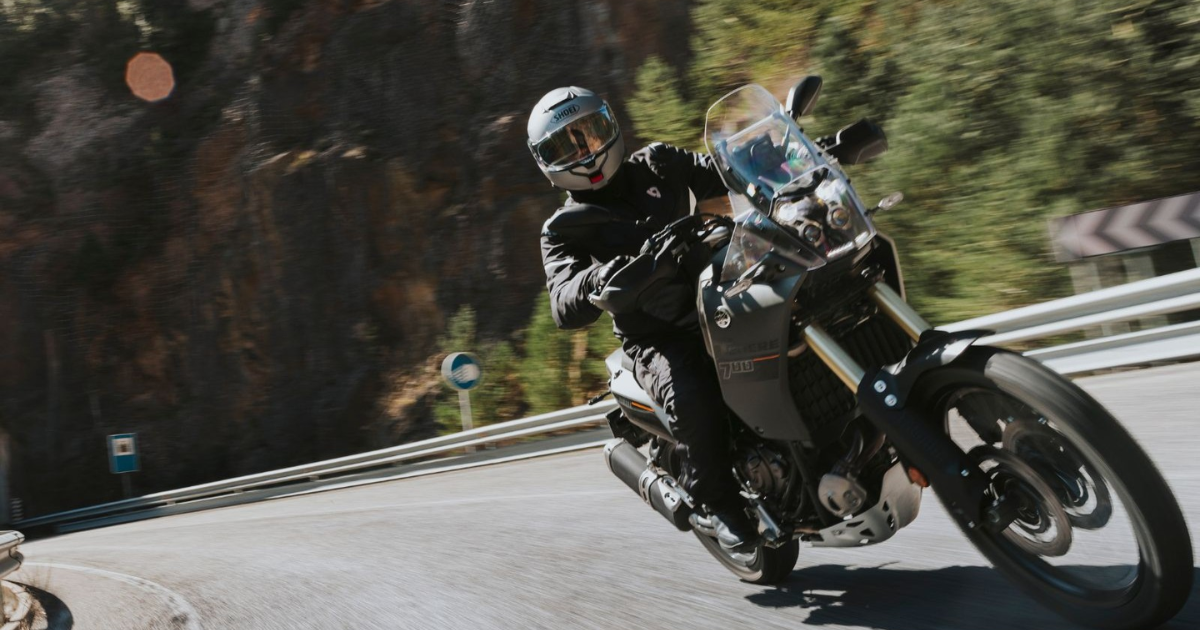
Best Quietest Modular Motorcycle Helmets: Tune Out the Wind, Not the Ride
Discover the quietest modular helmets that turn wind roar into a whisper. Protect your hearing and arrive fresh on every ride.


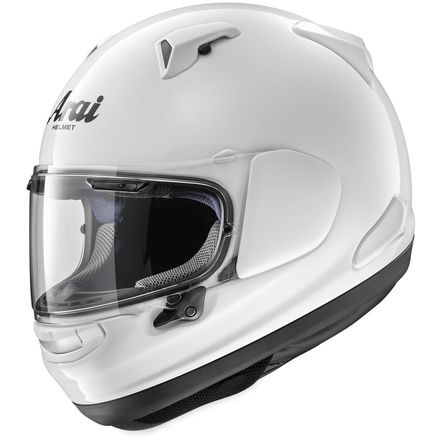

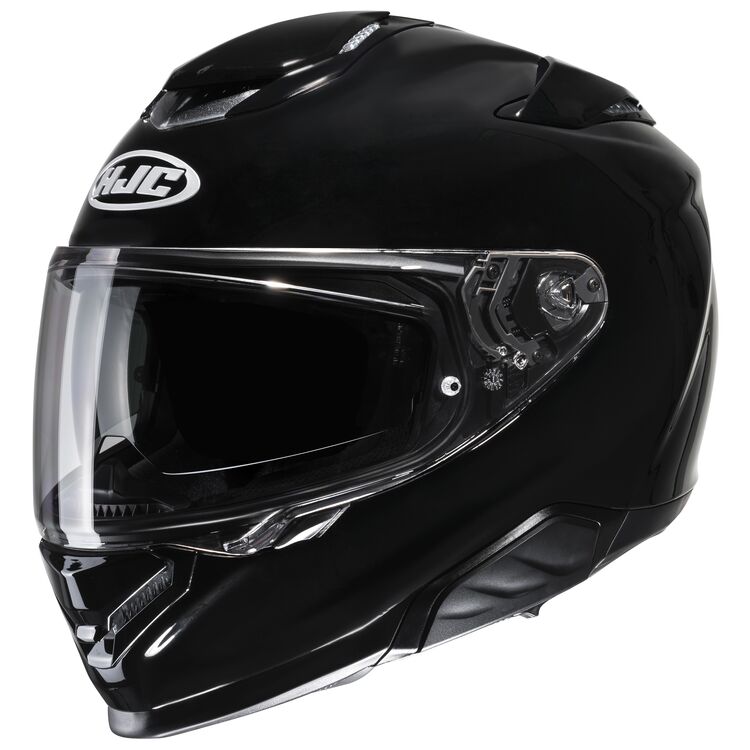
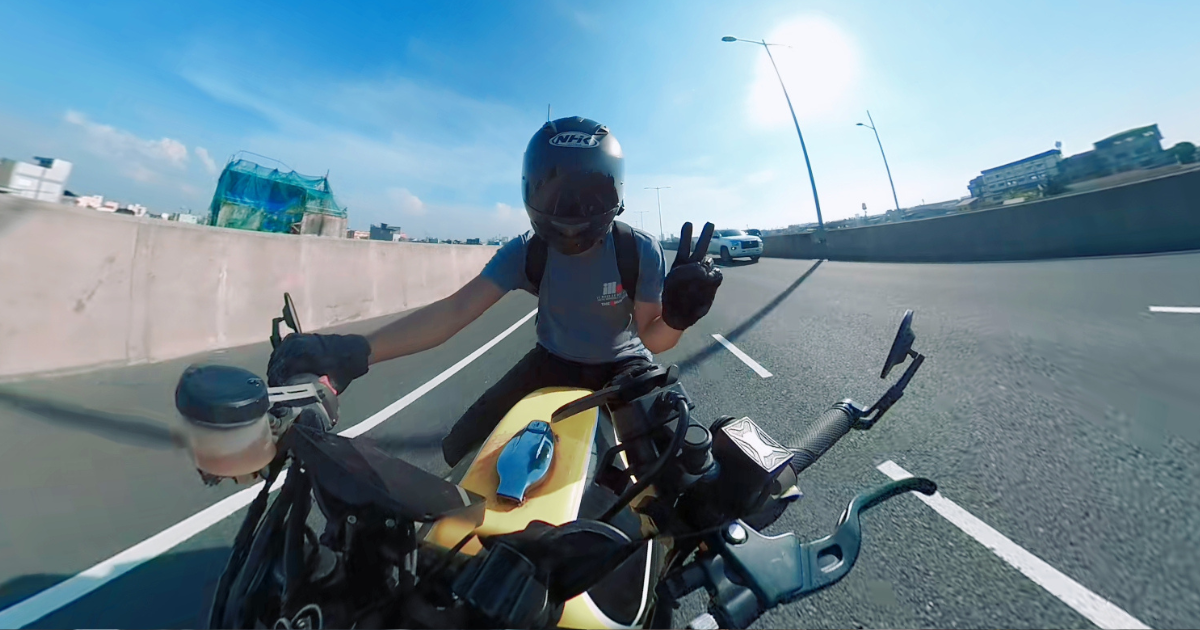

Vlad
6 months ago
While I agree with the interior material comfort, fit with pfs, low noise, and decent aerodynamics, I absolutely can’t stand how suffocating this helmet is unless I’m on a perfect position that forces air into it on a bike with a windscreen, I’m always hot and starving for oxygen (which causes a headache) even with everything open (one time I tried using a chin curtain and had to pull over because I felt like I was going to pass out). Can’t say I’ve put it on much (mostly reserve it for colder days) after getting a supertech r10 which is louder, much worse in terms of sena audio quality/volume due to the speaker placement, and can hurt my elephant ears if I don’t wear a skull cap, seems like a-stars transition shield gets darker than shoei, or at least I don’t get as much eye strain and don’t squint as much with it. Quantum-x that I had before was also much better in terms of ventilation, but it suffered from neck breaking/fatiguing aerodynamics and noise levels.
Evan Rally
6 months ago
Thank you for sharing, Vlad! Great experiences for others to read up on. Sorry the Shoei RF-1400 wasn’t solid for you.